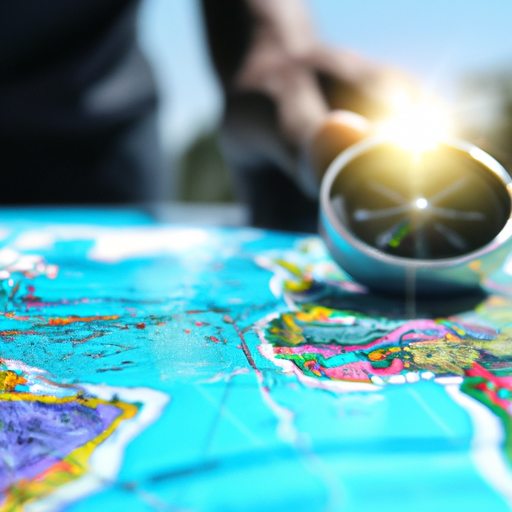
Have you ever found yourself in a new city, completely lost, and wishing you knew how to navigate to your desired destination? Don’t worry, we’ve all been there! In this article, we’ll discuss the ins and outs of navigating to a location, whether you’re traveling abroad or simply exploring a new neighborhood in your own city. By the end of this guide, you’ll have all the tips and tricks you need to navigate like a pro.
First things first, let’s talk about the basics of how to get to a location. One of the most common methods is using a GPS navigation system, either through a dedicated GPS device or a smartphone app. These nifty tools can give you turn-by-turn directions, letting you know exactly when to turn and how far you have until your destination. Plus, they often provide real-time traffic updates, helping you avoid any pesky traffic jams. But what if you don’t have access to a GPS device or reliable internet connection? Don’t worry, we’ll cover alternative methods like using maps, asking for directions, and even trusting your instincts. So, get ready to become a master navigator, because we’ve got you covered! Stay tuned for more tips and tricks in the upcoming article.
Table of Contents
How to Navigate to a Location

Understanding GPS Navigation Systems
GPS, which stands for Global Positioning System, is a satellite-based navigation system that allows users to determine their precise location. It works through a network of satellites that orbit the Earth, constantly transmitting signals that can be picked up by GPS receivers. These receivers use these signals to calculate the receiver’s exact latitude, longitude, and altitude. This information can then be used to navigate from one location to another.
How Does GPS Navigation Work?
GPS navigation systems combine the power of GPS technology with mapping databases to provide users with turn-by-turn directions to their desired destinations. When you enter a location or address into a GPS device, it calculates the best route based on the shortest distance, fastest time, or other customized preferences. It then guides you through visual and audio instructions, ensuring that you can reach your destination with ease.
Types of GPS Navigation Systems
There are various types of GPS navigation systems available in the market, each with its own features and capabilities. Some common types include:
-
Standalone GPS Devices: These are dedicated GPS devices that are designed solely for navigation purposes. They often come with larger screens, advanced features, and are typically mounted on the dashboard or windshield of a vehicle.
-
Smartphones and Tablets: Many smartphones and tablets come equipped with built-in GPS functionality and can be used as navigation devices. There are also numerous navigation apps available for download, such as Google Maps and Waze, which provide GPS navigation capabilities.
-
In-Dash Navigation Systems: These systems are built into the dashboard of a vehicle and provide seamless integration with the vehicle’s audio and entertainment systems. They often offer additional features, such as real-time traffic updates and voice recognition.
-
Wearable GPS Devices: Wearable GPS devices, such as smartwatches and fitness trackers, can also provide navigation assistance. Though they have smaller screens, they are convenient for activities like hiking or running, where carrying a smartphone or standalone GPS device may be impractical.
Choosing the Right GPS Device
When it comes to choosing a GPS device, it’s important to consider your needs and budget. Here are some factors to consider:
Consider Your Needs and Budget
Think about how you intend to use the GPS device. If you mainly need it for occasional road trips, a smartphone or standalone GPS device might suffice. However, if you frequently drive in unfamiliar areas or need advanced features like real-time traffic updates, you might want to invest in a more sophisticated device.
It’s also important to set a budget for your GPS device. While there are expensive high-end options available, there are also more affordable alternatives that offer reliable navigation capabilities.
Key Features to Look for in a GPS Device
When selecting a GPS device, here are some key features to look for:
-
Screen Size and Display: Choose a device with a screen size that is comfortable for you to read and operate while driving. Additionally, consider the brightness and clarity of the display, as it can affect visibility in different lighting conditions.
-
Maps and Updates: Ensure that the GPS device comes with up-to-date maps and has the capability to receive regular updates. This will ensure that you have accurate and reliable navigation information.
-
Voice Guidance: Look for a device that offers clear and understandable voice guidance instructions. This will allow you to keep your eyes on the road while receiving directions.
-
Points of Interest (POIs): Check if the GPS device has a comprehensive database of points of interest, such as restaurants, gas stations, and hotels. This feature can be useful when you need to find nearby amenities while on the road.
-
Real-Time Traffic Updates: Consider whether the device has the ability to provide real-time traffic updates. This feature can help you avoid congestion and find alternative routes.
Comparison of Popular GPS Brands and Models
To help you make an informed decision, here’s a brief comparison of some popular GPS brands and models:
-
Garmin: Known for their reliability and innovative features, Garmin offers a wide range of GPS devices for cars, bikes, and outdoor activities.
-
TomTom: TomTom is another well-known brand that produces GPS devices with user-friendly interfaces and accurate maps.
-
Google Maps: This navigation app, available for smartphones, offers detailed maps, real-time traffic updates, and voice-guided directions.
-
Waze: Waze is a community-based navigation app that provides real-time traffic updates, road alerts, and information crowdsourced from other users.
Before purchasing a GPS device, take the time to research and compare different models and read reviews to ensure that the device meets your specific needs.

Preparing for Your Journey
Before embarking on a journey, it’s essential to gather information about your destination, plan your route in advance, and check for any traffic updates or road closures. Here’s how to prepare for a hassle-free journey:
Gathering Information About Your Destination
To ensure a smooth trip, gather information about your destination. Research landmarks, major intersections, and nearby amenities. Familiarize yourself with the area so that you have a general idea of the roads and the layout of the destination.
Planning Your Route in Advance
Once you have gathered information about your destination, it’s time to plan your route. While GPS devices can provide you with turn-by-turn directions, it’s always a good idea to have a general sense of the route you’ll be taking. Take note of major highways, junctions, and any specific landmarks you’ll encounter along the way.
Checking for Any Traffic Updates or Road Closures
Before hitting the road, it’s advisable to check for any traffic updates or road closures. Pay attention to local news, traffic websites, or use a GPS device that provides real-time traffic information. This will help you avoid unexpected delays and plan your journey accordingly.
Setting Up Your GPS Device
To make the most of your GPS device, it’s crucial to properly set it up and customize the settings to suit your preferences. Here’s how to get started:
Installing the GPS Device in Your Vehicle
If you’re using a standalone GPS device, follow the manufacturer’s instructions to mount it securely in your vehicle. Ensure that it is within your line of sight but doesn’t obstruct your view or interfere with the operation of the vehicle.
Activating and Initializing Your GPS Device
Once your device is properly mounted, you’ll need to activate and initialize it. This process may involve entering some basic information, such as your location and time zone, into the device. Follow the on-screen instructions or refer to the device’s user manual to complete the setup process.
Customizing Settings and Preferences
Take the time to explore the settings and preferences on your GPS device. Adjust the volume, language, and measurement units, if necessary. You may also have the option to customize the route preferences, such as selecting the fastest or shortest route, avoiding tolls or highways, and more.

Using GPS Navigation
Now that your GPS device is set up, it’s time to put it to use. Here’s how to effectively use GPS navigation:
Entering an Address or Location
To begin navigating to a location, enter the address or location into your GPS device. Use the on-screen keyboard, if available, to input the information accurately. Double-check that you have entered the correct details before proceeding.
Understanding the User Interface
Familiarize yourself with the user interface of your GPS device. Pay attention to the map view, which displays your current location, the route, and any upcoming turns. Take note of the various buttons and icons that allow you to interact with the device, such as zooming in and out of the map and accessing additional features.
Following Turn-by-Turn Directions
Once you have entered your destination, your GPS device will provide you with turn-by-turn directions. Follow the on-screen instructions and listen to the voice guidance to navigate your way to your location. Pay attention to any upcoming turns, lane guidance, and distance remaining. Remember to keep your eyes on the road and use the voice guidance as a supplement.
Utilizing Advanced Navigation Features
GPS navigation systems offer a range of advanced features that can enhance your navigation experience. Here are a few notable features to take advantage of:
Finding Points of Interest
Need to find a nearby gas station, restaurant, or hotel? Most GPS devices have a built-in database of points of interest (POIs) that can help you locate amenities while on the road. Simply search for the desired POI category, and the device will provide you with a list of options along your route or in the vicinity.
Using Voice Commands
Many GPS devices now support voice commands, allowing you to interact with the device hands-free. This can be particularly useful while driving, as you can request directions, change settings, or perform other functions without taking your hands off the wheel or your eyes off the road.
Avoiding Traffic Congestion
GPS devices with real-time traffic updates can help you avoid congestion and find alternative routes. These devices use live traffic data to suggest the fastest route based on current conditions. By choosing an alternative route, you can save time and reduce stress during your journey.

Troubleshooting Common GPS Navigation Issues
Even with advanced technology, GPS navigation systems may occasionally encounter issues. Here are some common problems and their solutions:
Dealing with GPS Signal Loss
If you experience GPS signal loss, make sure that the GPS device has a clear view of the sky without any obstructions, such as tall buildings or dense foliage. Restarting the device or moving to an open area can help restore the GPS signal.
Updating Maps and Software
Regularly updating the maps and software on your GPS device is important to ensure accurate navigation. Most GPS devices offer the option to download updates via Wi-Fi or through a computer. Check for these updates periodically and follow the instructions provided by the manufacturer to install them.
Resolving Navigation Errors
If you encounter navigation errors, such as incorrect routes or missing destinations, double-check the address or location entered into the GPS device. Ensure that the device is using the latest maps and update if necessary. If the issue persists, consider contacting the manufacturer’s customer support for further assistance.
Safety Tips for Effective Navigation
While GPS navigation systems are designed to enhance your journey, it’s important to prioritize safety. Here are some safety tips to keep in mind while using GPS navigation:
Paying Attention to the Road
Despite the convenience of GPS, it’s crucial to remain attentive to the road and other traffic. Glance at the GPS device only when it is safe to do so. Use voice guidance as much as possible to minimize distractions and keep your focus on the road ahead.
Using GPS Responsibly
Remember that GPS devices are aids and not substitutes for responsible driving. Use GPS navigation as a tool to assist you in reaching your destination but always trust your judgment and follow traffic regulations. Avoid making sudden maneuvers or unsafe decisions solely based on GPS instructions.
Having a Backup Plan
While GPS navigation is convenient, it’s wise to have a backup plan. Keep a physical map or familiarize yourself with alternative routes in case your GPS device encounters technical difficulties or loses signal. This ensures that you can continue your journey without relying solely on technology.

Staying Up to Date with Technology Advancements
GPS navigation technology is continuously evolving, introducing new features and innovations. Here’s a glimpse of what the future holds:
New Features and Innovations in GPS Navigation
As technology advances, GPS navigation systems continue to introduce new features, such as augmented reality (AR) overlays, pedestrian mode, and integration with smart home devices. These advancements aim to make navigation more intuitive, convenient, and tailored to individual preferences.
Future of GPS Technology
The future of GPS technology holds the promise of improved accuracy, faster updates, and increased connectivity. Advancements in satellite systems, such as the Global Navigation Satellite System (GNSS), will contribute to more reliable and seamless navigation experiences.
Integration with Other Devices and Services
GPS navigation systems are increasingly being integrated with other devices and services. For instance, voice assistants like Amazon Alexa and Google Assistant can provide GPS directions and interact with your GPS device hands-free. This integration allows for a more interconnected and convenient user experience.
Conclusion
GPS navigation systems have revolutionized the way we travel, providing accurate and reliable directions to our desired destinations. By understanding how GPS works, choosing the right device, and following best practices for navigation, you can make your journeys more efficient and stress-free. Remember to navigate responsibly, prioritize safety, and stay informed about the latest advancements in GPS technology. Happy travels!

